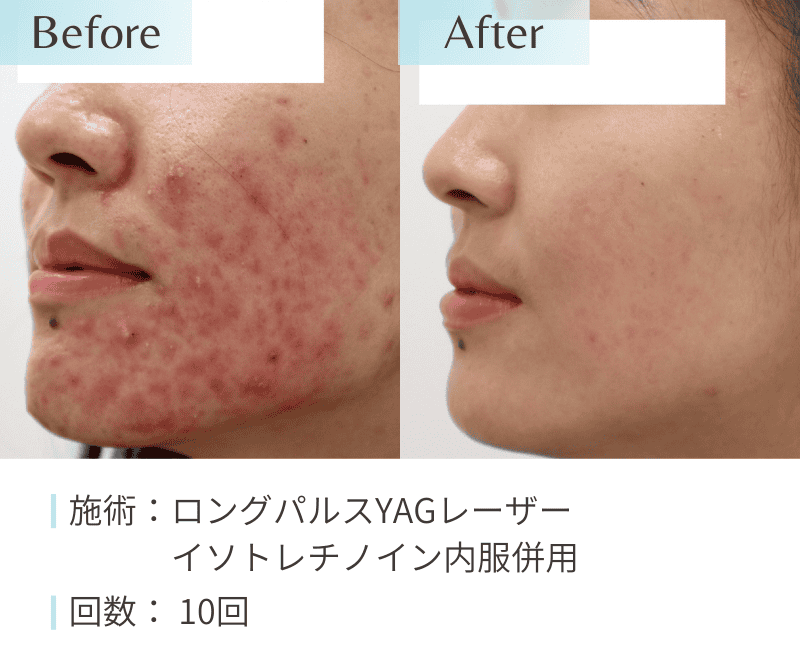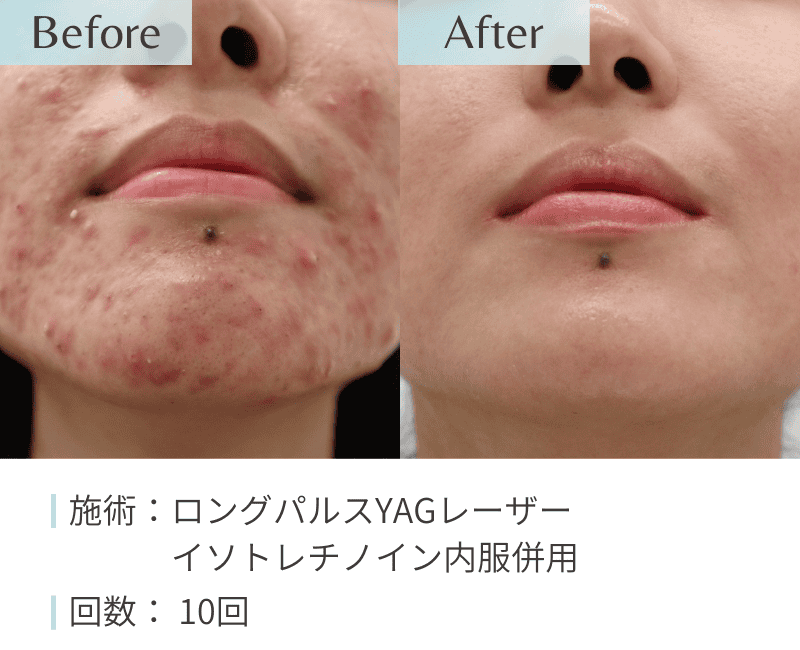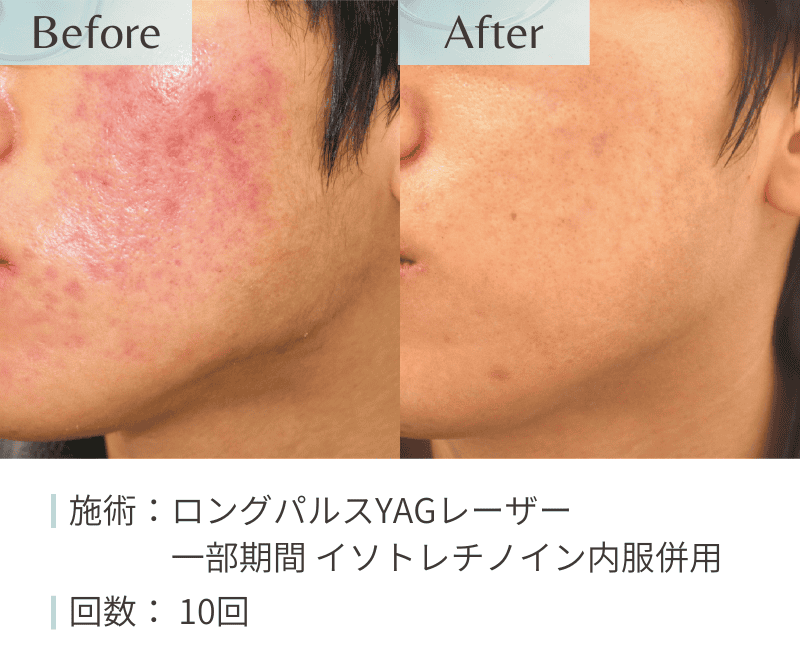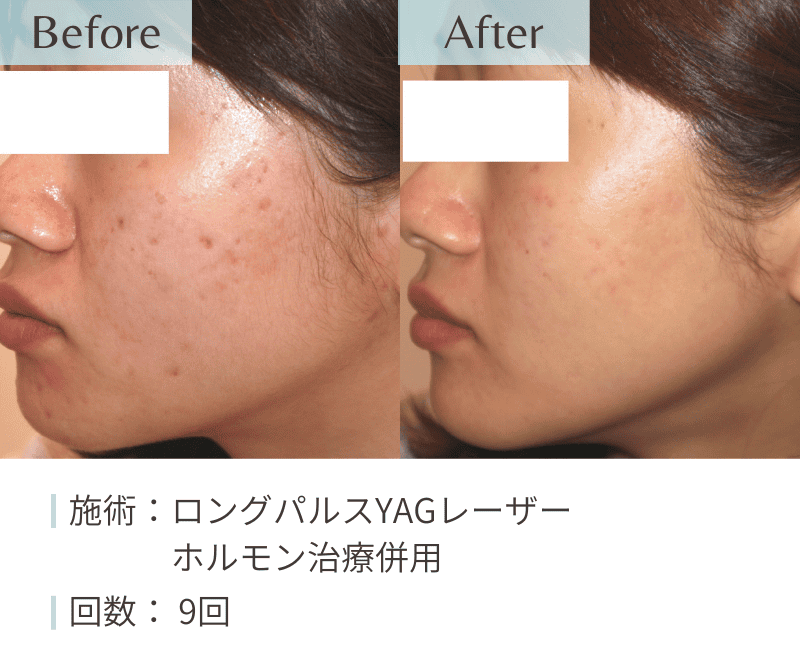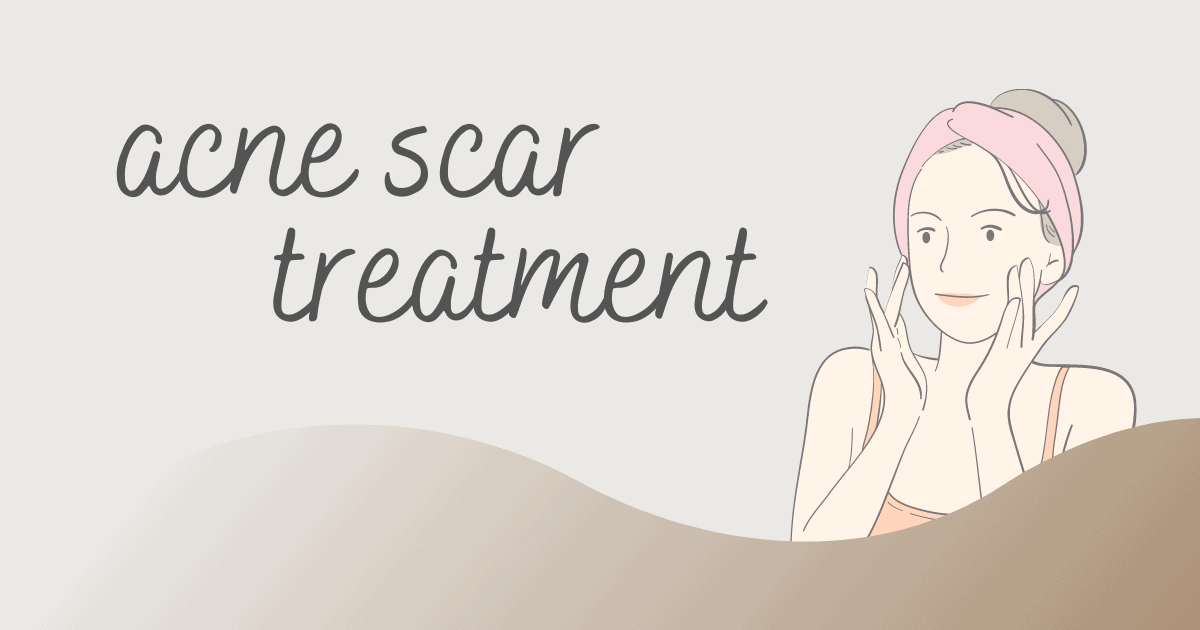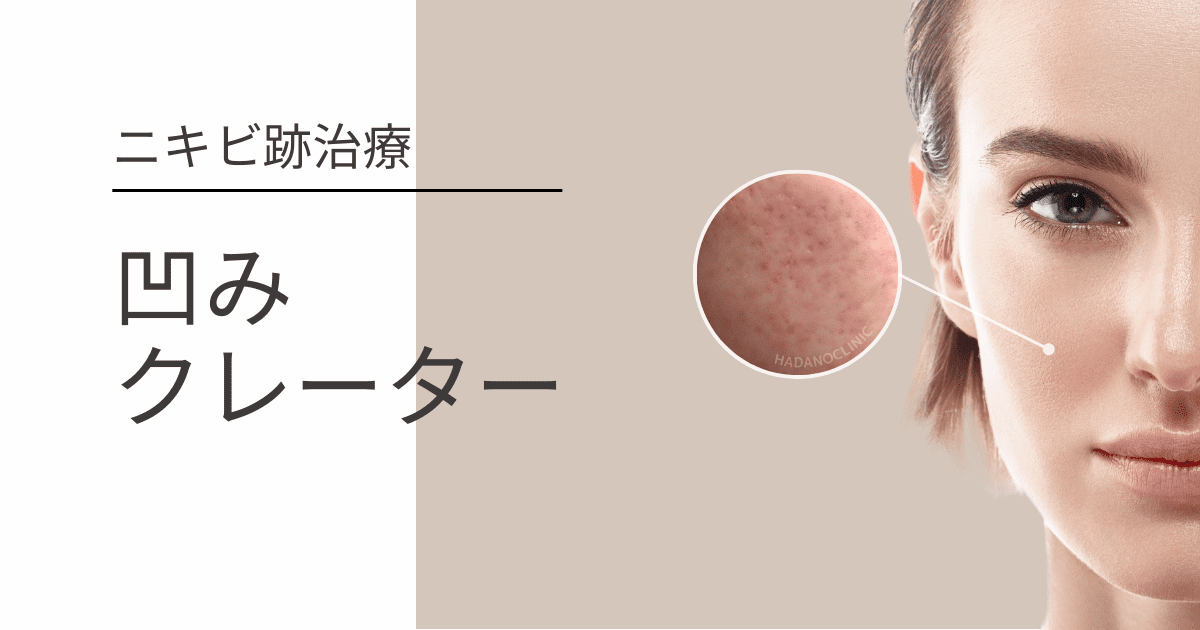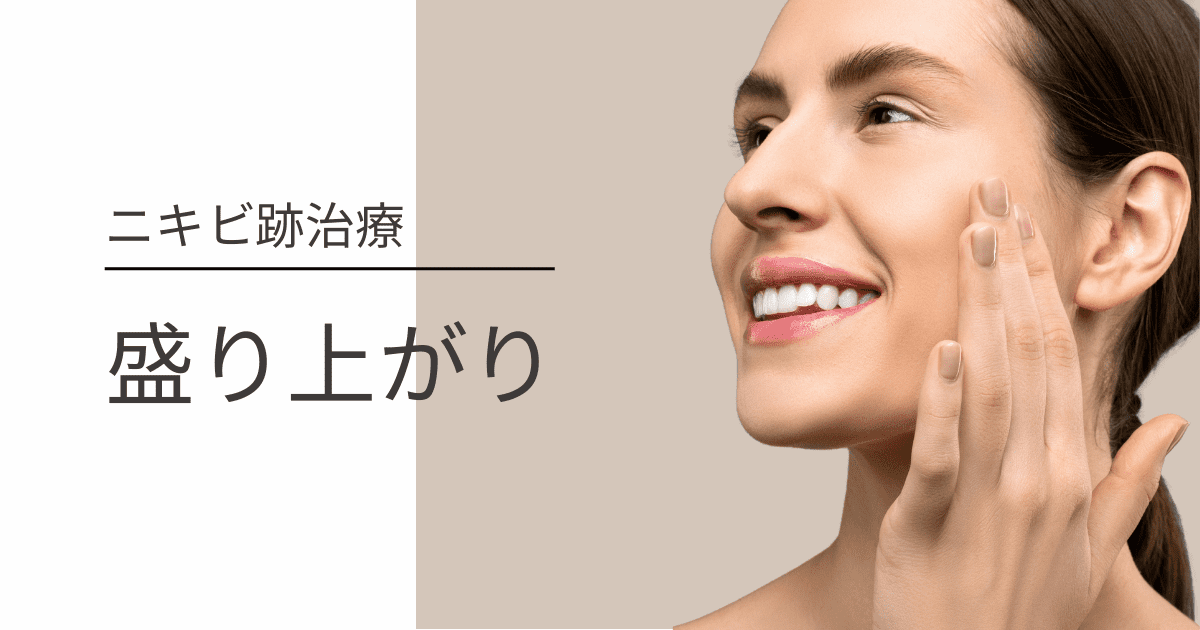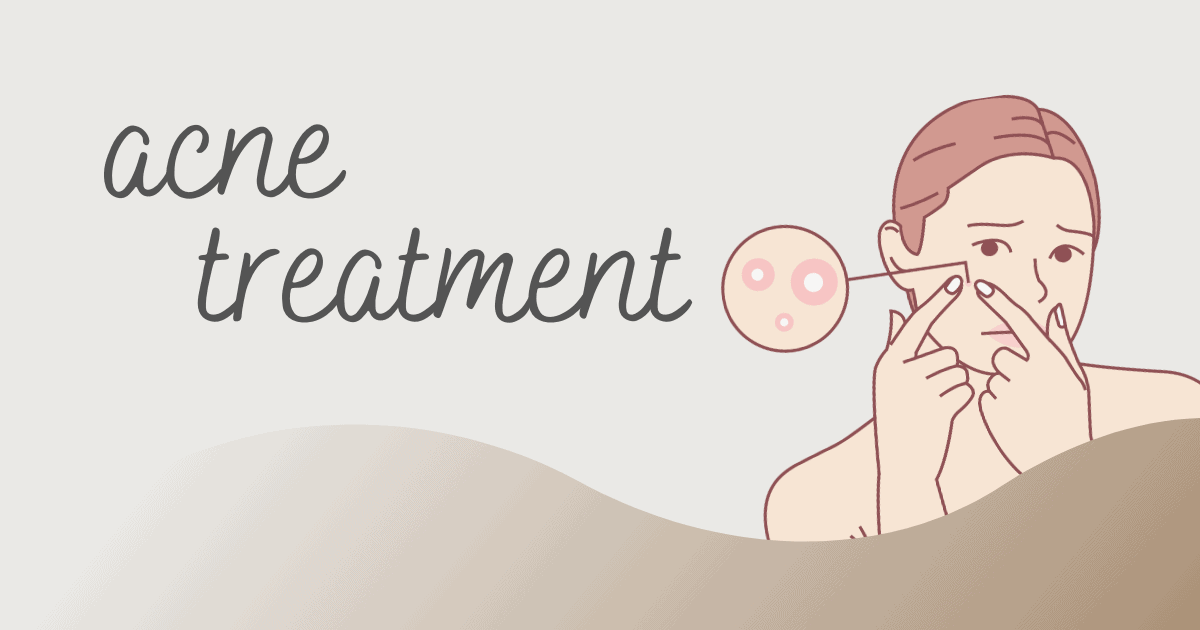Causes of Red Acne Scars
Post-Inflammatory Erythema and Post-Inflammatory Hyperpigmentation
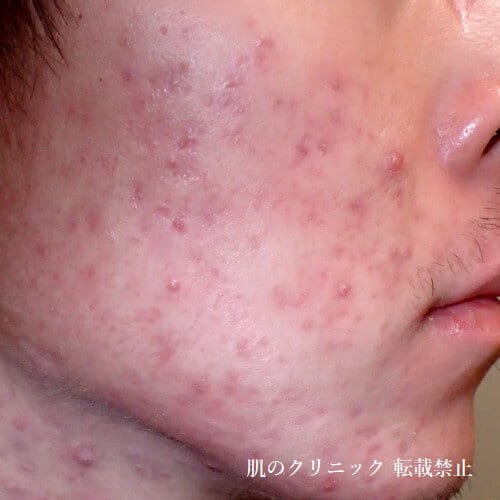
Redness in acne scars is called Post-Inflammatory Erythema (PIE). The primary cause of this redness is hemoglobin contained in red blood cells.
When acne inflammation occurs, skin cells become damaged, and during the healing process, blood vessels dilate and new capillaries form. This is what makes the skin appear red.
Additionally, inflammation can destroy capillaries, causing red blood cells to leak into the skin tissue, which can result in prolonged redness.
Brown pigmentation from acne scars is called Post-Inflammatory Hyperpigmentation (PIH). This occurs when acne inflammation stimulates melanin-producing cells, leading to excessive melanin production and the development of brown to black spots and discoloration.
Typically, post-inflammatory erythema and pigmentation naturally fade within six months, but depending on depth and individual constitution, they may persist for several years or longer.
Causes of Long-Lasting Red Acne Scars
Normally, when inflammation subsides, capillaries contract and redness naturally fades through skin turnover. However, in cases of severe inflammation or deep acne, capillaries may remain without retracting.
Particularly when red blood cells leak into the dermal layer, the slow turnover rate (5-6 years or more) can cause redness to persist for extended periods. This mechanism is similar to tattoos – when pigment deposits in deeper layers, it becomes difficult to remove.
Types and Color Variations of Red Acne Scars
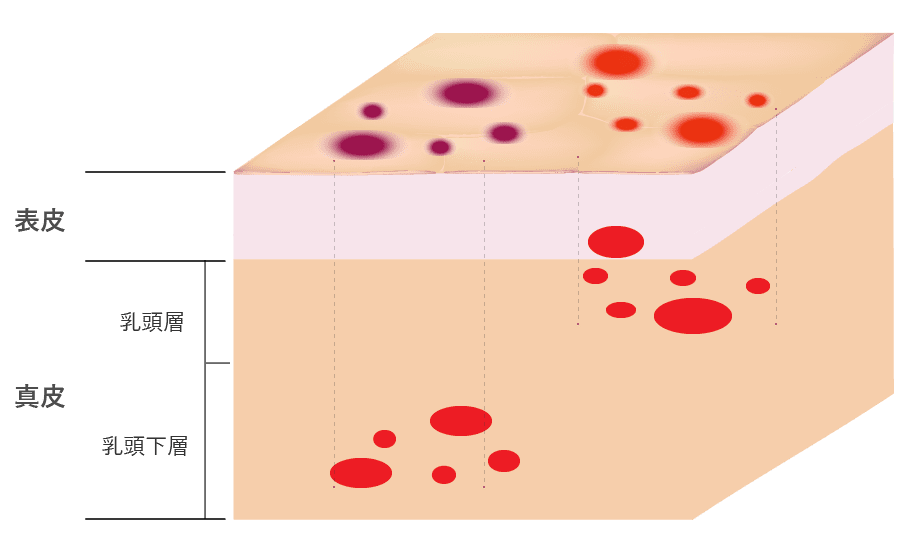
Red acne scars come in various color tones:
- Erythema: Dilated and congested capillaries (strong redness)
- Purpura: Red blood cells that have leaked from capillaries and oxidized to purple
When hemoglobin is in the superficial layers of skin (papillary layer), it appears red, while in deeper layers (subpapillary and below), it appears red-purple to red-black.
Hemoglobin appears red when oxygen is bound (oxyhemoglobin), but when oxidized, it becomes deoxyhemoglobin and appears red-purple or blue-black.
Treatment Methods for Red Acne Scars
Treatment for red acne scars combines multiple methods based on duration, color depth, and skin type.
1. Peeling and Tretinoin Therapy
Tranex Reti Peel (Intensive Peeling)
- Effects: Skin quality improvement with retinol (4% concentration), comedone removal
- Downtime: Redness and peeling for about 10 days
- Recommended for: Those seeking stronger effects
Salicylic Acid Macrogol Peeling (Mild Peeling)
- Effects: Promotes turnover, comedone removal
- Downtime: Minimal
- Recommended for: Sensitive skin or those avoiding downtime
Tretinoin & Hydroquinone Therapy
- Effects: Promotes skin turnover, melanin suppression
- Downtime: Redness and peeling for about 14 days
- Application: Effective for localized redness
2. Laser Treatment
Long-Pulse Nd:YAG Laser (1064nm)
- Effects: Contracts dermal capillaries, gradually reducing redness
- Frequency: Average 10 sessions at 2-week intervals
- Pain: Mild
- Downtime: Minimal (makeup possible same day)
Dual Treatment (Long-Pulse Nd:YAG + Toning)
- Effects: Simultaneously improves redness and dullness
- Frequency: Average 10 sessions at 2-week intervals
- Pain: Mild
- Downtime: Minimal (makeup possible same day)
- Recommended for: Those concerned with both redness and pigmentation
High-Power Long-Pulse Nd:YAG Laser
- Features: High-power, large-spot laser for more intensive redness improvement
- Frequency: Average 5-10 sessions at 1-month intervals
- Pain: Strong (anesthesia option available)
- Downtime: 1-3 days of redness
3. Oral Medications & Skincare
Isotretinoin (Oral)
- Effects: Promotes turnover, anti-inflammatory action supporting capillary regression
- Recommended for: Those seeking enhanced laser effectiveness
Whitening Oral Medications (Tranexamic Acid, Vitamin C, Glutathione)
- Effects: Prevents post-inflammatory pigmentation, whitening
Benefits of Combining Isotretinoin with Laser Treatment
- Enhanced skin turnover allows faster elimination of laser-treated redness
- Removal of acne and comedones promotes capillary regression
- Reduces post-laser reactive folliculitis
- Thinner stratum corneum allows deeper laser penetration
Treatment Progress Photos for Acne Scar Redness
Treatment Results
| Treatment | Cases |
|---|---|
| Long-Pulse Nd:YAG Laser | 2023: 1,873 cases 2024: 1,725 cases |
| Dual Treatment | 2023: 501 cases 2024: 428 cases |
| Treatment | Cases |
|---|---|
| High-Power Long-Pulse Nd:YAG Laser | 2023: 964 cases 2024: 812 cases |
Treatment Costs– Treatment Costs –
| Treatment | Price (Tax Included) |
|---|---|
| Consultation Fee | Initial consultation ¥3,850 Follow-up ¥1,650 |
| Toning Laser | First time full face (3000 shots) ¥8,580 Subsequent (3000 shots) ¥10,780 Neck (full face option) ¥3,300 Half face (1500 shots) ¥6,380 5×5cm (500 shots) ¥3,080 Body 1 area (2500 shots) ¥9,680 |
| Long-Pulse Nd:YAG Laser | First time full face (5000 shots) ¥9,680 Subsequent (5000 shots) ¥12,980 Neck (full face option) ¥3,300 Half face (2500 shots) ¥8,580 5×5cm (600 shots) ¥3,300 Body 1 area (3000 shots) ¥9,680 |
| Dual Treatment | First time full face (8000 shots) ¥18,260 Subsequent (8000 shots) ¥19,360 Neck (full face option) ¥6,600 Half face (4000 shots) ¥13,860 5×5cm (1100 shots) ¥5,390 Body 1 area (5500 shots) ¥17,160 |
| High-Power Long-Pulse Nd:YAG | Full face ¥27,280 Neck (full face option) ¥8,800 Half face ¥16,280 5×5cm ¥5,280 |
| Tranex Reti Peel | In-clinic treatment face ¥16,500 Take-home treatment face ¥14,300 *Body pricing varies by area |
| Salicylic Acid Macrogol Peeling 30% 40% | In-clinic treatment face ¥7,480 Take-home treatment face ¥4,378 Take-home 6 treatments face ¥21,780 *Body pricing varies by area |
| Tretinoin 0.05% 5g | ¥2,178 |
| Tretinoin 0.1% 5g | ¥2,728 |
| Hydroquinone 4% 10g | ¥3,278 |
- Acne scar treatment is limited to patients without active acne. We will also recommend acne treatment for patients with active breakouts.
- For patients receiving the same treatment for the second time or more, consultation fees are waived if no consultation is desired.
- For patients purchasing cosmetics, topical medications, or vitamins for the second time or more, consultation fees are waived if no consultation is desired.
- Take-home Tranex Reti Peel requires a minimum of 3 in-clinic treatments and guidance sessions.
Frequently Asked Questions About Redness & Pigmentation
- Are there cases where laser treatment cannot be performed?
-
Patients with active acne cannot receive acne scar treatment, so we will recommend acne treatment as well.
Additionally, laser treatment may not be suitable for the following individuals:
- Sun enthusiasts, those with sun-exposed occupations, or those with photosensitivity (sun allergy)
- Pregnant women
- Those with epileptic seizures
- Those with gold thread implants
- Those with tattoos, permanent makeup, or permanent foundation (BB Glow, CC Glow, etc.) in the treatment area
- Those using medications that increase light sensitivity
Please consult with our physicians during your examination for details. Also refer to our “Treatment Intervals” page.
- Which is better, peeling or laser treatment?
-
This depends on the characteristics of your acne scars (color, depth) and individual skin condition, so please consult with our physicians during your examination. For skin type, we recommend peeling for oily skin or thick stratum corneum, while laser treatment is preferred over peeling for sensitive or dry skin.
- What is the treatment duration and frequency for redness?
-
For typical acne scar redness, the treatment period is approximately 6 months to 1 year. Visit frequency and number of sessions: Long-Pulse Nd:YAG Laser averages 10 sessions at 2-week intervals, while peeling and high-power long-pulse treatments require 5-8 sessions at 4-week intervals.
- Can treatment be performed without downtime?
-
For redness, treatment can be performed with minimal downtime concerns, except for certain treatments. Tranex Reti Peel causes peeling for about 7-10 days. Tretinoin-hydroquinone therapy has a period of 2-3 weeks with redness and peeling.
- What should I be careful about after laser or peeling treatment?
-
Maintain proper moisturization and pay careful attention to UV protection. Bathing and face washing can continue as usual, but avoid rubbing the skin as much as possible. Our clinic recommends “medical cosmetics” for daily skincare.

